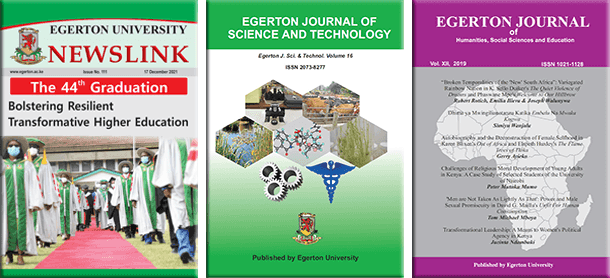Reversing Emigration: Implications for Policy Makers
By Peter Ondari Rosana
Traditionally, international migration trends involved people migrating from countries with less advanced living standards to those which had prospects of a better quality of life. Most of us are familiar with this trend where emerging economies have been losing millions of their productive citizens to the developed world. However, some emerging economies are now investing in pull factors that can work towards overturning this trend, and hopefully slow down the urge by citizens to settle in other countries, or even entice those who have already migrated to return “home”. As a result, some destinations that were not very popular are now beginning to attract huge numbers of migrants. In this essay, I attempt to understand why this trend is gaining popularity in some parts of the world. I also draw some lessons for emerging economies like Kenya on how to slow down emigration of productive citizens through reverse emigration.
As earlier noted, most international migration tends to be from countries with less favourable conditions to those with better living standards and relative peace. Currently, the most industrialised nations like the USA, France, Germany, the UK, and the United Arab Emirates are the leading destinations for such migrants. For instance, in 2016 alone, the USA recorded 1.8 million cases of legal immigrants. Reports show that over 80 per cent of the population of the United Arab Emirates comprises of legal immigrants who primarily provide the workforce for the industries in that country.
On the other hand, countries like India, Pakistan, Bangladesh, Afghanistan, Mexico, and China, are among the leading nations in the number of emigrants. What factors could be causing this trend, and how are they likely to evolve? We can only answer these questions by conducting a trend analysis of these factors and understanding the conditions in these countries. This knowledge will help us identify patterns and project what to expect over time. Based on current trends and mitigation strategies, the most likely result is a reversed order of migration, a situation called reverse international migration.
There are several factors that cause international migration. These conditions help us understand why people are migrating the way they do and the likely changes in migration trends. The first one is the economic status of the countries of origin compared to the destination country. For instance, about 870,000 migrants moved into the USA from Mexico between 2013 and 2018. Most of them moved there to look for employment opportunities and better economic standards like markets for their goods. Secondly, people move to other nations in search of quality education. This is most prevalent among African nations from which people move to the UK, USA, and India because these destinations have some of the best higher learning institutions globally. The third factor is climate change. Countries like Bangladesh and Kiribati are among the most affected because of climatic effects like cyclones and rising sea levels. For example, about 1/7 of the population in Bangladesh is projected to have migrated from there by 2050. Afghanistan is also experiencing prolonged drought, making it one of the most uninhabitable nations in the Middle East. Lastly, some of the countries experiencing the highest levels of emigration are those experiencing political unrest and civil war. Countries like Burkina Faso, Myanmar, the Democratic Republic of Congo, Afghanistan, and Libya are among the most affected. The political turmoil in these regions has driven thousands of people out of those nations as they seek better living conditions for their families.
Despite these prevailing circumstances, current and past trends show a possibility of reversing these operations. Governments are working tirelessly to make their nations more habitable. International bodies like the United Nations High Commission for Refugees (UNHCR) are also working towards resettling many displaced people back to their original countries. If the current measures are implemented efficiently, analysts project that by 2050 people will be migrating back to where they are moving from today. The conditions driving them out of their home countries will no longer exist. Alternatively, the increased population could reduce the pull factors in these destinations. For instance, if the population of industrialised nations increases significantly, there will be population pressure, and access to social amenities like healthcare facilities and jobs will be affected. Those living in those countries will likely have to move out in search of better conditions. This will, in turn, present further opportunities and challenges to both the sending and receiving countries.
In many nations, governments are as well working to create more employment opportunities. For instance, the migration rate from Mexico to the USA will likely reduce significantly by 2025 under President Andres Manuel. In August 2022 alone, his administration created over 20,000 jobs in Mexico City. The quality and availability of compulsory education have also increased over the past few years, increasing the number of professional workers. Lastly, the government has a job creation scheme in the Caribbean that will ensure that over 80 per cent of the population lives above the poverty line. On the other hand, the USA is working to reduce illegal migration from its southern border and to deport illegal immigrants back to Mexico, reversing the migration trend forcefully.
In education, Africa now has some of the best universities in the world. For example, the University of Johannesburg was founded in 2005 but is currently ranked among the top 500 universities in the world. Other institutions like the University of Cape Town and the University of Witwatersrand also rank highly on the global scale. In Kenya, Egerton University is now attracting global attention and has several international students from the rest of Africa and Asia. The University has also formed partnerships with other universities like the University of Ohio, and students can come to Egerton or go to Ohio to study. The need for quality higher education is now met locally, and countries like Kenya, from which people moved for further studies, could become major destinations for international students.
Thirdly, several bilateral and multilateral environmental agreements and organisations have been established to curb climate change. For example, the United Nations, founded after the Second World War, took up the responsibility to devise ways of managing the environment. They have developed sustainable development goals to reduce global warming to at most a rise of 2 degrees Celsius within the next 100 years. In Bangladesh, the government is offering adaptive services to over 40,000 families to cope with climate change. They have also set up 224 new cyclone shelters. Kiribati is equally doing an excellent job by building dykes, traditional sea walls, and planting mangrove forests to alleviate the displacement rate by sea level rise. Finally, water-rich river basins in Afghanistan are being diverted to fill drier ones and get water for irrigation. The government is also investing heavily in drought-resistant crops and research to boost the nation’s food security. Over time, these places vulnerable to climate change will become more habitable, attracting people to migrate and live there.
Lastly, the intensity and cases of war in most parts of the world are now reducing. Once a haven for terrorists, Somalia now has Dowladda Soomaaliya – the government of Somalia. With governance in place, terrorism and insecurity are bound to reduce. Former USA President Barrack Obama also withdrew all combat activity from Afghanistan and instead started offering support to the locals and their defence forces. In Myanmar, it is projected that military rule in the nation will soon end, and they will form a central government. With working rules in place, developers and investors will migrate there and get citizenship, reversing the migration trend. In addition, organisations like the United Nations Disengagement Observer Force are also working to restore global peace. Once countries like Libya regain political stability, their economic development will be rapid since they have resources like natural gas. Consequently, people will scramble to settle in the country instead of relocating from there.
This reverse migration trend will have some implications for policymakers in both the sending and receiving countries. First, the sending countries are likely to face labour shortages as their workforce migrates to other countries. There is also the possibility of experiencing brain drain if skilled citizens opt to settle elsewhere. On the receiving end, there may be technology transfer, a need for new immigration policies, and reduced diaspora remittances. While the emigrants may also move out with some skills, these abilities may not be applicable or recognised in their new residence, making it hard for them to settle and adapt. As this trend starts to set in, policy makers from both nations need to assess the impact of the phenomena, form partnerships, and device ways of dealing with any challenges that may come with the shift.
In conclusion, no one may like to live in hostile conditions. For this reason, governments are working to ensure such circumstances are alleviated. They are bound to succeed. This will reduce the rate of migrating out of such places. Eventually, people will start moving back to those locations; a situation called reverse international migration. Whether in a few or many years, reverse international migration is inevitable.






